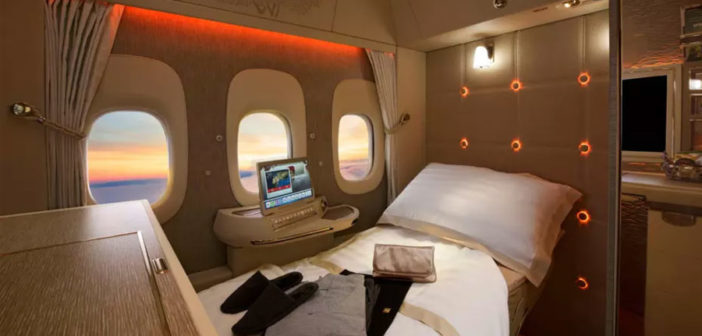Emirates plans to make virtual windows the norm on all of its future planes–but to succeed, it will need to balance great UX with logistical efficiency.
If you think too hard about what it means to fly in an airplane–hurtling through the air at hundreds of miles an hour, thousands of feet above the ground, in a giant metal tube–you might not be able to stomach flying at all. And if planes didn’t have windows, they might feel even more claustrophobic. Nonetheless, windowless planes are coming, and they could make planes lighter–and thus cheaper to fly. But they also represent a UX challenge for designers: How do you convince people to get on a plane where they can’t see the world outside?
This week, Emirates unveiled a first-class cabin, aboard its Boeing 777-300ER planes, that has only virtual windows made up of digital screens that display the landscape as fiber-optic cameras outside the plane record it. As Emirates’s president Tim Clark told the BBC, the airline’s goal is to bring fake windows to all airplanes in the future.

Clark says that removing windows could make airplanes about 50% lighter because of the complexity windows add to the structure of a plane. And lighter planes means less fuel–and lower costs. “So if you have got a composite fuselage, which is produced in one drum . . . with no windows, the aircraft is automatically much lighter, the wings are already lighter because they are composite,” he told ABC. Plus, he says, the quality of the images are “better than with the natural eye.”
The images of the first class cabins with virtual windows do make them look completely natural. But we all know how technology tends to work in reality: glitches happen. How disorienting would it be for your “window” to start to flicker and all of a sudden go black? Claustrophobia–and the sensation of not being in control–is a real challenge for many passengers. Not being able to truly see the outside world might deepen the feeling. Ultimately, this is a design problem of balancing efficiency with user experience. Emirates’s designers will need to gain user trust if they expect windowless planes to become truly ubiquitous. That means creating a system that’s unfailingly reliable and high-resolution enough to make passengers forget they’re looking at a screen.
There aren’t any real safety concerns with having no windows, though one aviation expert told the BBC that it’s important for the flight crew to be able to see outside in an emergency. One compromise could involve designing real windows near emergency exits, but fake ones everywhere else. (After all, if there was a real problem, all the windows short-circuiting would certainly add to the panic.)
Still, it seems as though windowless planes are on the way after years of concepts imagining what they would look like. And if they work, I’d take a windowless plane–and a cheaper ticket–any day.
–
This article first appeared in www.fastcodesign.com
Seeking to build and grow your brand using the force of consumer insight, strategic foresight, creative disruption and technology prowess? Talk to us at +9714 3867728 or mail: info@groupisd.com or visit www.groupisd.com




